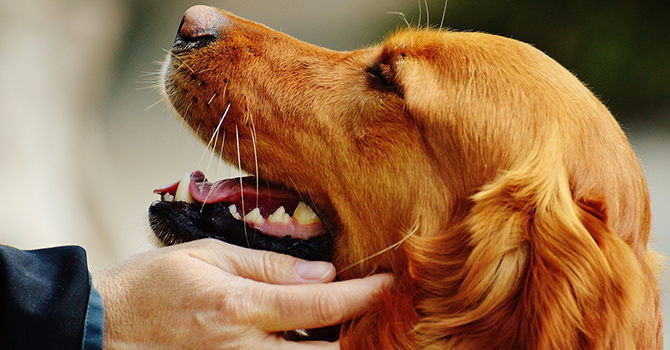Q&A: How Pets Can Help Older Adults Manage Chronic Pain

New Research from Mary Janevic
New research led by Mary Janevic, associate research scientist in Health Behavior and Health Education at the University of Michigan School of Public Health, found that pets have the potential to help older adults cope and function better with chronic pain.
In fact, many of the strategies that are recommended for self-managing chronic pain—including staying physically and socially active and engaging in distraction, relaxation, and pleasurable activities—can be facilitated by the presence of pets.
“For example, dogs might help people stick to a walking routine, and having a purring cat on your lap can be relaxing,” Janevic said. “Engaging in pet care can give a sense of daily purpose and routine that keeps a person going, even when they are having a pain flare-up. In this way, pets can be thought of as a ‘natural’ resource for chronic pain self-management.”
For this study, Janevic and her collaborators conducted four focus groups with a total of 25 men and women ages 70 and older who owned a dog and/or a cat and had persistent pain from any health condition that impacted their daily functioning. In group discussions, participants described how their pets affected their daily routines and health, including pain and pain management.
We talked to Janevic to find out more about this research and what she and her team learned.
According to your findings, in what specific ways does owning a pet help older adults manage chronic pain?
We heard from our focus group participants about a number of different ways that owning a pet can help older adults manage chronic pain. These align nicely with recommended pain coping strategies. A few examples:
- Relaxation—A number of people told us that their pets seemed to sense when their owner was in pain and would stay physically close and attentive, which was soothing.
- Distraction—Thinking about their pet’s needs gets people’s minds off their own bodies, keeping them from focusing too much on their pain. Additionally, pets bring enjoyment and laughter, which can also help distract people from pain.
- Physical activity—Dog walking and other pet-care activities that require people to get moving can help alleviate pain.
- Staying engaged—Having a pet motivates engagement in daily activities and social interaction even when pain is present, which is important for maintaining quality of life.
- Mood management—Pets increase positive feelings, which are shown to be associated with less pain, and decrease negative feelings, which are associated with more pain.
Were there any surprises in your findings?
We already knew that having a dog can help older adults stay active—for example, through regular walks. But we were surprised to hear from some of the cat owners in our study that their animals also helped them stay active—if not from walking, from tasks like changing litter and getting fresh food and water.
We were also surprised to hear how often people said their pets kept them going when they were experiencing a lot of pain or otherwise not feeling well. This is a key message of pain self-management—that it is often helpful to “keep going” even while experiencing some level of pain. This can help prevent a downward cycle of inactivity and low mood, both of which can ultimately lead to more pain.
Why were you interested in learning how pets can help older adults manage chronic pain?
There is a lot of interest right now in safe, effective, non-pharmacological ways to manage long-term pain. Psychological and behavioral self-management strategies can help people with chronic pain improve daily functioning while minimizing risks associated with medications.
We need to think creatively about ways to motivate people to use chronic pain self-management techniques in their everyday lives. For pet owners, their furry companions may be a “hook” to get them interested in pain self-management.
Pets are a very common social resource—we found in another recent study that more than half of older Americans have pets—and they get a lot of enjoyment out of them. Calling attention to how companion animals can help people manage pain also highlights the fact that people do in fact have some control over their pain experience, and that even simple things like taking care of and interacting with pets may be therapeutic for pain.
What, if any, downsides of pet ownership did you uncover in this research?
First, it’s important to keep in mind that not every pet owner living with long-term pain is going to be helped by their pet.
We confirmed that pets can also cause stress—for example, when they have behavior or health issues, or if people worry about their ability to care for their pets. And of course, people experience grief when a pet dies.
A few people in our study mentioned instances of pets actually making pain worse, such as a dog pulling too hard during a walk or laying on a bad leg.
We know from previous studies that people sometimes feel tied down by pets, in terms of getting out of the house and traveling. So that should also be considered, as well as the fact that pets have the potential to cause falls.
To be clear, we are not recommending that people who don’t already have a pet should get one to manage their pain. Neither this study nor any other has proven that if people who don’t already have a pet acquire one, they will be healthier. Pet ownership is a complicated decision and requires a careful weighing of pros and cons. Instead, we simply found that for some older adults, their pets seemed to play an important role in helping them live better with pain.
Other University of Michigan researchers involved in the study include Cathleen Connell, Varick Shute, John Piette, and Jenna Goesling. Julie Fynke from Wayne State University was also involved in the study.
